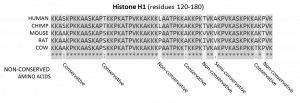This week in ENGL 301, we are studying the best practices for writing definitions. I was tasked with writing a parenthetical definition, a sentence definition, and an expanded definition. I chose to define the term “bioinformatics” because it is one of my interests as well as complex enough for an expanded definition. Part of the requirements was to cite at least three sources for our definitions using the MLA or APA reference style. I chose MLA. We also needed to use at least four expansion methods for our expanded definition. The methods I used were to include examples, use a visual, analyze different parts of bioinformatics, and outline the requirements for a field of study to be part of bioinformatics. Finally, we needed to define the audience our definitions were for and in what situation they would be reading them.
Reading situation:
The audience I am writing for is other university students that have achieved the high school required understanding of very basic biology. This includes understanding what DNA, RNA, protein, organisms, and cells are. They should have at least basic computer literacy. The situation is that students are reading about bioinformatics to see if they are interested in studying it.
Parenthetical Definition:
Because of the overwhelming amount of data that is available from experiments investigating the molecules and cells that make up living organisms, bioinformatics (the use of software and computer algorithms to interpret biological data from experiments) has become extremely important in synthesizing large amounts of data into an interpretable and useable result (Luscombe et al. 346).
Sentence Definition:
Bioinformatics is a branch of science where computer science is used to work with and understand biological data. This includes using computers to analyze and compare DNA, RNA, and protein sequences to learn how the organisms they come from function (Austin).
Expanded Definition:
Bioinformatics is a branch of science where computer science is used to work with and understand biological data. This encompasses the writing of computer code to work with such data, as well as the use of bioinformatics computer programs that have already been written. Bioinformatics has become more important as the amount of experimental data becomes larger over time (Luscombe et al. 346).
Bioinformatics is most often associated with the analysis and comparison of DNA, RNA, and protein sequences. Computer programs are able to find regions of similarity between sequences. If two sequence regions are similar and the biological function of one of the regions is known, then it can often be inferred that the other region will have a similar function (Austin). For example, if we know the sequence of a protein that chemically breaks down a sugar, and we have another protein that shows sequence similarity to the first protein, then there is a good chance the second protein also breaks down a sugar.

Figure 1. An example of the output of a program that compares protein sequences called “ClustalO”. The program is used to find regions of proteins that are similar.
Source: https://commons.wikimedia.org/wiki/File:Histone_Alignment.png
There are three ways in which bioinformatics works with data: helping to store and organize large amounts of data into databases, analyzing the data that has been stored, and interpreting analyzed data to get useable facts about biological systems (Luscombe et al. 346-347). An example of storing and organizing data would be DNA sequence databases like GenBank. The U.S. National library of medicine has connected the GenBank DNA database to the internet so that it can be accessed by researchers internationally. It is organized so that it can be easily searched using a DNA sequence entered into the browser. Searching with a DNA sequence will return all the DNA sequences from the database that show sequence similarity (GenBank). An example of analyzing biological data is the automatic analysis of cell images by software. If there are too many images of a cell type to go through manually, then a good strategy is to use a computer to do it automatically. Algorithms have been developed to identify different parts of a cell, and identify their visual characteristics. Furthermore, these algorithms can be used to go through all cell images and quantify the proportion of cells that have a particular visual characteristic. Biological Image analysis is also an example of getting useable facts about biological systems (Peng et al. 1057). In the case of cancer, some cells can have different visual characteristics (What). A useable fact is whether or not a collection of cells is cancerous.
Works Cited:
Austin, Christopher P. “Bioinformatics.” National Human Genome Research Institute. n.d. Web. 28 Sept. 2021. <https://www.genome.gov/genetics-glossary/Bioinformatics/>.
“GenBank Overview.” National Centre for Biotechnology Information. n.d. Web. 28 Sept. 2021. <https://www.ncbi.nlm.nih.gov/genbank/>.
Luscombe, Nicholas M., et al. “What Is Bioinformatics? A Proposed Definition and Overview of the Field.” Methods of Information in Medicine. vol. 40, no. 4, 2001, pp. 346–58.
Peng, Hanchuan, et al. “Bioimage Informatics: A New Category in Bioinformatics.” Bioinformatics (Oxford, England), 2012/03/06, vol. 28, no. 8, Oxford University Press, Apr. 2012, p. 1057, doi:10.1093/bioinformatics/bts111.
“What Do Doctors Look for in Biopsy and Cytology Specimens?” American Cancer Society. 30 July 2015. Web. 28 Sept. 2021. <https://www.cancer.org/treatment/understanding-your-diagnosis/tests/testing-biopsy-and-cytology-specimens-for-cancer/what-doctors-look-for.html>.
Leave a Reply